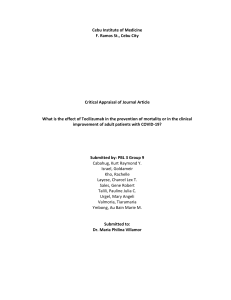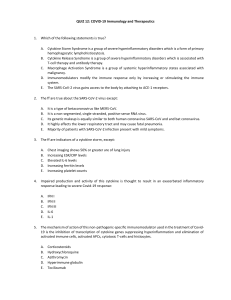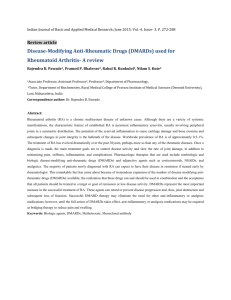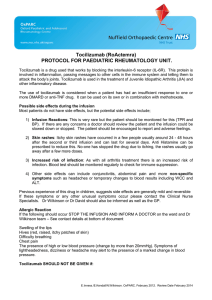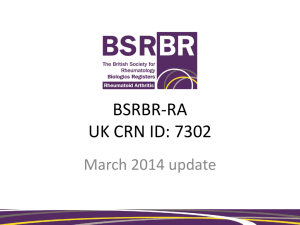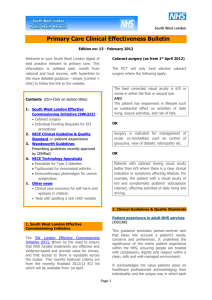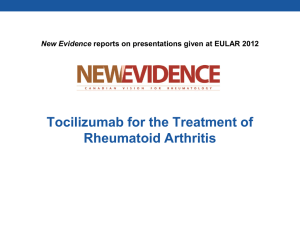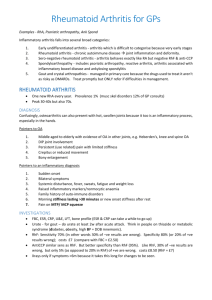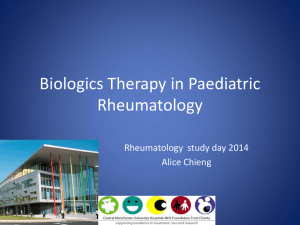Comments
advertisement
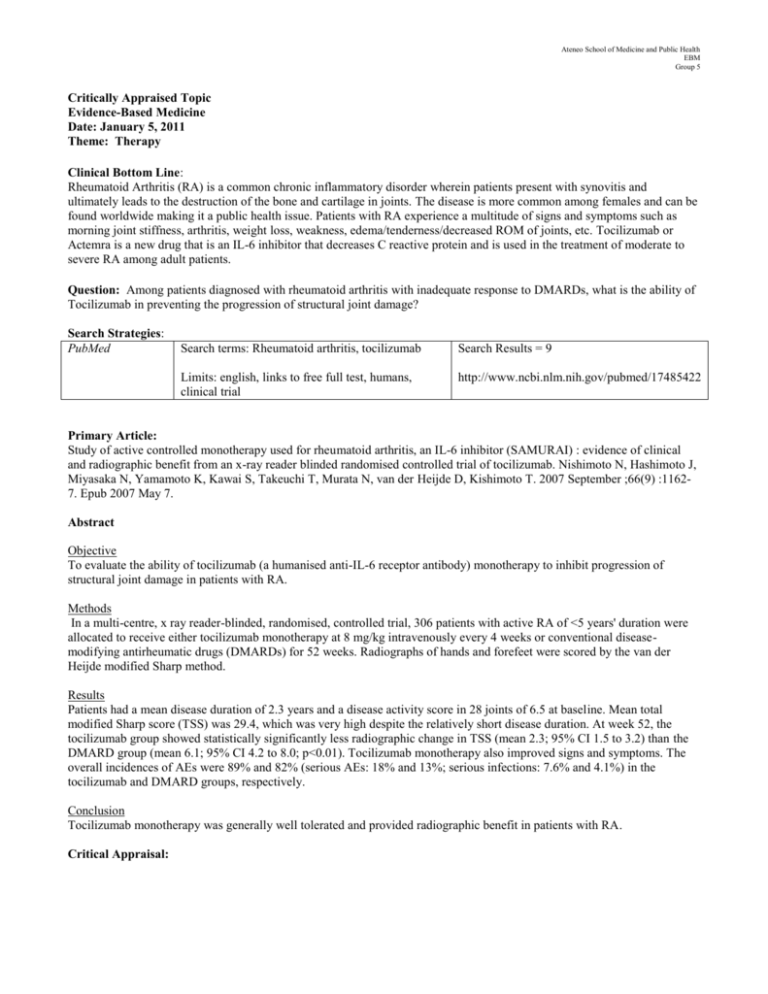
Ateneo School of Medicine and Public Health EBM Group 5 Critically Appraised Topic Evidence-Based Medicine Date: January 5, 2011 Theme: Therapy Clinical Bottom Line: Rheumatoid Arthritis (RA) is a common chronic inflammatory disorder wherein patients present with synovitis and ultimately leads to the destruction of the bone and cartilage in joints. The disease is more common among females and can be found worldwide making it a public health issue. Patients with RA experience a multitude of signs and symptoms such as morning joint stiffness, arthritis, weight loss, weakness, edema/tenderness/decreased ROM of joints, etc. Tocilizumab or Actemra is a new drug that is an IL-6 inhibitor that decreases C reactive protein and is used in the treatment of moderate to severe RA among adult patients. Question: Among patients diagnosed with rheumatoid arthritis with inadequate response to DMARDs, what is the ability of Tocilizumab in preventing the progression of structural joint damage? Search Strategies: PubMed Search terms: Rheumatoid arthritis, tocilizumab Search Results = 9 Limits: english, links to free full test, humans, clinical trial http://www.ncbi.nlm.nih.gov/pubmed/17485422 Primary Article: Study of active controlled monotherapy used for rheumatoid arthritis, an IL-6 inhibitor (SAMURAI) : evidence of clinical and radiographic benefit from an x-ray reader blinded randomised controlled trial of tocilizumab. Nishimoto N, Hashimoto J, Miyasaka N, Yamamoto K, Kawai S, Takeuchi T, Murata N, van der Heijde D, Kishimoto T. 2007 September ;66(9) :11627. Epub 2007 May 7. Abstract Objective To evaluate the ability of tocilizumab (a humanised anti-IL-6 receptor antibody) monotherapy to inhibit progression of structural joint damage in patients with RA. Methods In a multi-centre, x ray reader-blinded, randomised, controlled trial, 306 patients with active RA of <5 years' duration were allocated to receive either tocilizumab monotherapy at 8 mg/kg intravenously every 4 weeks or conventional diseasemodifying antirheumatic drugs (DMARDs) for 52 weeks. Radiographs of hands and forefeet were scored by the van der Heijde modified Sharp method. Results Patients had a mean disease duration of 2.3 years and a disease activity score in 28 joints of 6.5 at baseline. Mean total modified Sharp score (TSS) was 29.4, which was very high despite the relatively short disease duration. At week 52, the tocilizumab group showed statistically significantly less radiographic change in TSS (mean 2.3; 95% CI 1.5 to 3.2) than the DMARD group (mean 6.1; 95% CI 4.2 to 8.0; p<0.01). Tocilizumab monotherapy also improved signs and symptoms. The overall incidences of AEs were 89% and 82% (serious AEs: 18% and 13%; serious infections: 7.6% and 4.1%) in the tocilizumab and DMARD groups, respectively. Conclusion Tocilizumab monotherapy was generally well tolerated and provided radiographic benefit in patients with RA. Critical Appraisal: Ateneo School of Medicine and Public Health EBM Group 5 Was it randomized? Was randomization concealed? Was the follow up sufficiently long and complete? Validity Was the data analyzed on an intention to treat basis? Was there adequate blinding of subjects and researchers? Were there similar baseline characteristics in each group? Applicability Clinical Importance Groups treated equally other than intervention? Yes. A total of 306 patients were randomized and separated into treatment group (Tocilizumab) and those that received the conventional disease modifying anti-rheumatic drugs (DMARDs). The randomization was concealed from both the patients and the x-ray technicians that read and interpreted the results. The randomization of patients was performed by registering of patients at the patient registration center with a centralized allocation method. The study was done for a duration of 52 weeks. A total of 306 patients were enrolled, 148 in the DMARDs group and 158 in the Tocilizumab group. However 14% of patients withdrew from the DMARDs group and 23% of patients withdrew from the Tocilizumab group due to exacerbation of the disease during the trial, refusal of treatment and protocol violations. Yes. The results that was used to determine whether or not Tocilizumab was successful as compared to the conventional DMARDs was based on radiographic scores taken on week 28 and week 52 of treatment. Clinical indicators included here are the total sharp score, erosion score, and joint space narrowing score. It was not mentioned whether or not patients in the study were blinded with regard to what treatment they were receiving. However, the x-ray technicians that were tasked to interpret the radiographic results were blinded. Yes. Baseline characteristics of patients on both the DMARDs and the Tocilizumab groups were matched in terms of their demographics (age, male to female ratio), clinical characteristics (RA duration in years, number of tender and swollen joints, ESR, CRP) , radiographic findings (modified TSS, erosion score, joint space narrowing score), and all candidates had an inadequate response to at least one DMARD in the past. Yes. For both groups, they were not allowed to undergo surgical treatment and the use of bisphosphonates during the trial. Safety was also prioritized for both groups in terms of recording adverse events, performing regular physical examinations and doing standard laboratory tests. What is the magnitude of treatment effect (e.g. what is the relative risk reduction, absolute risk reduction, NNT)? Are any differences between patient and those studied different enough that you would not apply these results? As long as the baseline characteristics of the patients used in the study will also match the baseline characteristics of Filipino patients diagnosed with RA, there will be no difference. The study was also performed in Japan, another asian country which gives us a similar racial background. Ateneo School of Medicine and Public Health EBM Group 5 Is treatment feasible? Patient preferences Benefits vs harms Yes. The drug is distributed in the Philippines by Zuellig and is available at Mercury Drug store. Administration of the drug is simple, one 8mg/kg IV infusion every 4 weeks making compliance easy. The only possible hindrance for Filipinos to avail of this treatment would be the high cost. Mild to moderate AEs were experienced by 89% and 832% in the Tocilizumab and the DMARDs group. The most common AE was nasopharyngitis, but the incidences were similar in both groups. Serious AEs were experienced in 18% and 135 in the Tocilizumab group and DMARDs group. These include serious infections (pneumonia, URTI, cellulitis, gastroenteritis, herpes zoster), and mild drug related infusion reactions. Despite all this, Tocilizumab monotherapy was generally well tolerated. The study showed that despite the AEs experienced, the Tocilizumab therapy still provided significant radiographic benefits in patients with RA as compared to those taking DMARDs. Comments Ateneo School of Medicine and Public Health EBM Group 5 .
